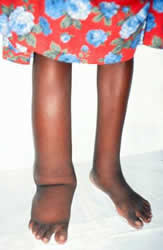Filariasis history and symptoms: Difference between revisions
No edit summary |
No edit summary |
||
| Line 9: | Line 9: | ||
[[Image:Lymphedema2.jpg|150px|left]] | [[Image:Lymphedema2.jpg|150px|left]] | ||
Lymphatic filariasis can cause | |||
[[Elephantiasis]] (frequently in the lower extremities) | |||
Scrotal swelling and scrotal elephantiasis (patients with Wuchereria bancrofti) | |||
[[Nocturnal cough]] | |||
[[Wheezing]] | |||
[[Fever]] | |||
Onchocerciasis can cause | |||
[[Pruritus]] | |||
[[Dermatitis]] | |||
The most serious manifestation consists of [[ocular]] lesions that can progress to [[blindness]]. | |||
Loiasis (Loa loa) can cause | |||
Asymptomatic | |||
Episodic [[angioedema]] (Calabar swellings) | |||
Infections by Mansonella perstans can cause | |||
Asymptomatic | |||
[[Angioedema]] | |||
[[Pruritus]] | |||
[[Fever]] | |||
[[Headaches]] | |||
[[Arthralgias]] | |||
[[Neurologic]] manifestations | |||
Mansonella streptocerca can cause | |||
[[Pruritus]] | |||
Papular eruptions | |||
[[Pigmentation]] changes | |||
Mansonella ozzardi can cause symptoms that include | |||
[[Arthralgias]] | |||
[[Headaches]] | |||
[[Fever]] | |||
[[Pulmonary]] symptoms | |||
[[Pruritus]] | |||
==References== | ==References== | ||
{{reflist|2}} | {{reflist|2}} | ||
Revision as of 17:24, 19 December 2012
|
Filariasis Microchapters |
|
Diagnosis |
|---|
|
Treatment |
|
Case Studies |
|
Filariasis history and symptoms On the Web |
|
American Roentgen Ray Society Images of Filariasis history and symptoms |
|
Risk calculators and risk factors for Filariasis history and symptoms |
Editor-In-Chief: C. Michael Gibson, M.S., M.D. [1] Associate Editor(s)-in-Chief: Kalsang Dolma, M.B.B.S.[2]
Overview
The most spectacular symptom of lymphatic filariasis is elephantiasis; thickening of the skin and underlying tissues; which was the first disease discovered to be transmitted by insects. Elephantiasis is caused when the parasites lodge in the lymphatic system. Elephantiasis affects mainly the lower extremities, whereas ears, mucus membranes, and amputation stumps are rarely affected; however, it depends on the species of filaria. W. bancrofti can affect the legs, arms, vulva, breasts, while Brugia timori rarely affects the genitals.
History and Symptoms

Lymphatic filariasis can cause
Elephantiasis (frequently in the lower extremities)
Scrotal swelling and scrotal elephantiasis (patients with Wuchereria bancrofti)
Onchocerciasis can cause
The most serious manifestation consists of ocular lesions that can progress to blindness.
Loiasis (Loa loa) can cause
Asymptomatic
Episodic angioedema (Calabar swellings)
Infections by Mansonella perstans can cause
Asymptomatic
Neurologic manifestations
Mansonella streptocerca can cause
Papular eruptions
Pigmentation changes
Mansonella ozzardi can cause symptoms that include
Pulmonary symptoms
References